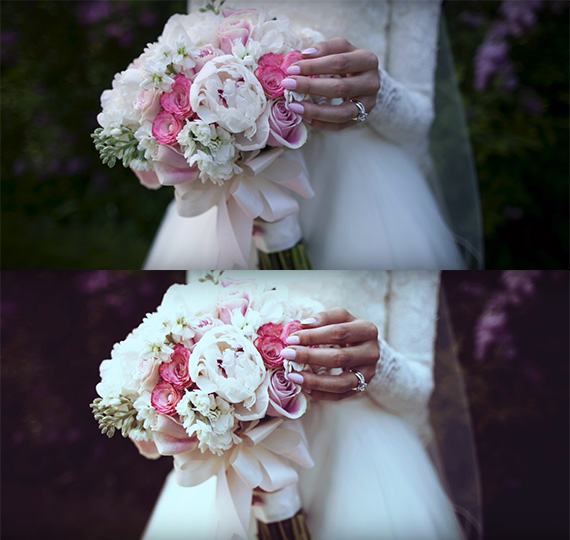When a client starts asking a professional photographer for RAW, unedited photos from their portrait session or wedding day, things can get a little messy. In the following video, Detroit-based portrait photographer and graphic designer Jessica Kobeissi breaks down the complexities of this issue and describes the reasons why photographers should never give RAW files to clients:
RAW files are not final products
In Kobeissi’s view, providing RAW files and unedited images to clients could potentially undermine your entire brand. Unedited images are essentially unfinished products.
“It’s kind of like building a house,” said Kobeissi. “You need the bricks and the wood, but you’re not going to keep the bricks and the wood by themselves. You need to put them together to create a beautiful house.”
Prospective clients may get the wrong impression

TOP: The unedited RAW file. BOTTOM: The edited version of the same image.
Since RAW files are merely raw materials that photographers use along with digital image editing to create beautiful images, handing out unedited images will give clients and anyone else they allow to view the photos an inaccurate picture of your talents and unique style.
“We don’t want people judging us or having a bad image of us by seeing our unedited photos because that doesn’t reflect our finished product,” said Kobeissi. “We want to make sure that whatever people see in public is an accurate representation of both ourselves and our skills.”
Clients would need special tools and software to open the files anyway
Another reason to withhold RAW files from clients is that, chances are, they wouldn’t even be able to open the files with their current computer software. CR2 files can only be opened in specific programs like Adobe Photoshop and Lightroom CC. Additionally, clients probably won’t have the storage space on their hard drives to store thousands of huge RAW files, each of which can easily exceed 25 megapixels.
It allows clients to edit and manipulate your art without your consent
As Kobeisii explains, when a client asks for the RAW files from their session, what they’re really asking for is the equivalent of a painter’s partially-painted canvas:
“Giving our unedited photos opens the window for people to manipulate and edit our images without our consent. It’s like giving someone a rough draft of your script that you’ve been working on and then having them edit and add things in there and then releasing the final version.”
It is absolutely necessary to edit RAW files

TOP: The unedited RAW file. BOTTOM: The edited version of the same image.
Since RAW files are not edited or compressed by camera software at the time of capture, photographers are able to record the maximum amount of detail. This is great, but only if you’re going to edit your work. Unprocessed RAW images look dim and flat, so editing is absolutely necessary to make them shine.
“A lot of photos are purposefully shot a little bit darker so that we can bring out details,” said Kobeissi. “We don’t want people to see how it looks before processing so people don’t think that we’re bad photographers.”
Most clients are unhappy with unedited photos
Clients who ask for unedited photos generally don’t know what they’re asking for and usually feel very dissatisfied when they see the pictures.
“I’ve had people get unedited photos and let me tell you, they’re usually not happy,” said Kobeissi.
Quality is more important than quantity

LEFT: The unedited RAW file. RIGHT: The edited version of the same image.
It’s important to try to get clients to understand the value of quality over quantity. It may be natural for them to feel that receiving more images is a better return for their investment, but this is usually easily remedied by showing them before and after images that demonstrate the benefits of retouching.
“Would you rather have 150 beautifully retouched photos or would you rather have 2,000 unedited, dimly-lit, average-looking photos? We want to make sure [clients] love [their] photos as much as we do,” said Kobeissi.
One foolproof way to avoid having conflicts with clients over unedited images is to include contract language which specifically states that no unprocessed RAW files will be given out. You should also provide clients with a basic estimate for the number of photos they should expect to receive from you. Otherwise, clients might feel disappointed—and even cheated!—when your delivery doesn’t meet their expectations.
As always, it’s always a good idea to educate your clients about the whole process of shooting and editing. Keep them in the loop and let them know you’re happy to answer their questions. They’ll love you for it!
Like This Article?
Don't Miss The Next One!
Join over 100,000 photographers of all experience levels who receive our free photography tips and articles to stay current:





Raw files are the digital negative. The client has the right to ask for them
If a photographer is not willing to hand over the raw files, they are not worth paying for,
and are often hiding their inept ability.
Otherwise ask a photographer to shoot the entire wedding on film.
The examples used in this article are good reason why they should hand over the raw files.
they are both awful, certainly not something id be happy paying for.
Good discussion on why photographers SHOULD provide unedited photos:
“I don’t see photographers as providing finished pieces of work (such as a can of Coca-Cola), but rather acting as contractors. I’ve hired organizations to build websites. I can’t imagine one ever refusing to turn over source code and instead forcing us to come to them for future updates.”
Based on thoose samples I wouild demand raw files or choose another photographer. They are overedited and overexposed. Ruined in my eyes. They are perfect example why customer would want raw file of particular image. I wonder if that is the best what that photographer can do. I believe there should be way better examples where editing really benefit to finished photo. But those examples are douing the opposite – promoting demand for raw files since they are just very badly edited. Sorry.